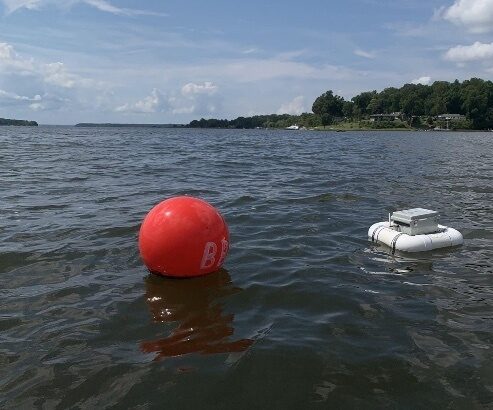MEET BOB! This Student Project is Bobbing Along in Breton Bay, Maryland

by Shelly O’Foran, long-time educator and project volunteer
In response to the need for cheaper and more widespread water quality monitoring in the Chesapeake Bay, teachers and students at the Dr. James A Forrest Career and Technology Center in Leonardtown, Maryland, are partnering with community volunteers to create inexpensive remote monitoring kits funded by a grant from the Chesapeake Bay Trust.
“This project has the potential to change the way people relate to and care for the Bay,” Natural Resources Management (NRM) Teacher Dorothy Birch said. “Knowing more about the surface water around us and the pollution challenges we face to keep our water clean will encourage people to get more active in protecting our waters.”
The kits, designed and assembled by volunteer Norm O’Foran with help from the school’s Engineering teacher and students, use microprocessor technology and cost about $800 each while comparable equipment sells for upwards of $20,000. They measure air temperature and humidity, water temperature at surface and bottom, dissolved oxygen, pH, electrical conductivity, total dissolved solids, and salinity.
Dubbed by students as Breton Observation Boxes (BOBs), several of the kits were placed in the Breton Bay watershed during student field trips in spring 2023. They are recording live data every 10 minutes, which can be viewed here: https://bit.ly/BOBswaterobs.
Developing a MWEE and finding support
The project was born a few years ago when Norm and Shelly O’Foran volunteered with Friends of St. Clements Bay to monitor water quality, a process that requires boating and hand sampling. Norm began developing an inexpensive, automatic solution using Internet of Things (IoT) makerspace microprocessors, and Shelly saw its educational potential as a year-long, Meaningful Watershed Educational Experience (MWEE) for high school students.
The couple collaborated with Dorothy Birch to apply for and receive a $5,000 Youth Environmental Education Grant from the Chesapeake Bay Trust for the 2022-2023 school year. The money pays for the supplies to build the BOB kits.
Lessons throughout the year explored elements of the MWEE framework. Students defined issues with research and planning, including examining pros and cons of automated versus handheld monitoring systems and brainstorming how to keep the buoys safe from boats and vandalism. They completed outdoor fieldwork in deploying the BOBs and taking comparative measurements at the Chesapeake Biological Laboratory (CBL) at Solomons Island, and they synthesized results and drew conclusions in writing articles, presentations, signage, and other publicity materials about the project. Finally, they engaged the school and local community in making a presentation at a Commissioners of Leonardtown meeting and posting an informational sign at the Leonardtown Wharf.
“The purpose of this project is not only to make water quality testing easier and the data more accessible, but also to help spread awareness of the Chesapeake Bay’s condition and why we need to ensure its health for its inhabitants.”
- Grace Anderson, student
Project engages multiple classes
Birch’s Natural Resources Management students led the project, but they received help from fellow students in Engineering and Graphic Communications in lessons such as: using microprocessors in prototyping, soldering solar panels, and branding and marketing the kits.
“To me, the best thing about this project was how interconnected the involvement was within the Tech Center,” said student Lola Gaytan. “Multiple classes worked together to create the best possible results. When we were confused, there were people there to guide us and to lean on when it otherwise could have felt very overwhelming.”
“I’ve learned to have more patience with the long process of this whole project, and I’ve learned how to get things done in a professional manner to serve the community,” noted student Jasper Dichter.
Birch agreed, saying, “The best part of this project has been watching the students really get into problem solving, seeing their ownership of local waters increase dramatically."
“I hope to see BOBs on docks around the world someday,” Birch concluded.
Contact Dorthy Birch at dcbirch@smcps.org if you’d like to learn more about this project or collaborate in using the BOBs data in the classroom.
Project Update (Summer 2024)
BOBs’ Water Quality Data and Lessons Now Available for Teachers
Piggyback on this MWEE project here, using the data and lessons in your class. After two years, the 14 Bay Observation Boxes have now collected over a million data points, and teachers and volunteers have created Data Detectives' mysteries and other materials for use in teaching everything from the importance of water quality monitoring to instrument calibration to data analysis and cleaning.
